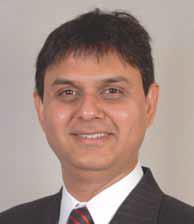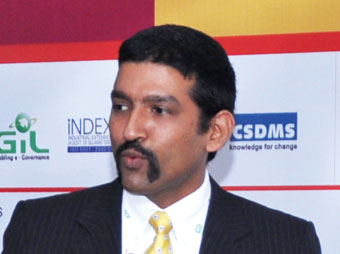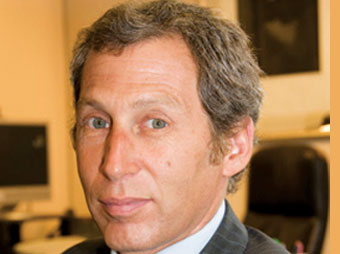
 A rainbow like collection of vibrant innovations and sky-high investments are enabling thehealthcare sector in India to grow at a scorching pace
A rainbow like collection of vibrant innovations and sky-high investments are enabling thehealthcare sector in India to grow at a scorching pace
By Dhirendra Pratap Singh, dhirendra@elets.in

As George Bernard Shaw once said, Progress is impossiblewithout change, and those who cannotchange their minds cannot change anything. Thelast year, defined by innovations and new technology trendsin healthcare, one word that dominated the global vocabularywas change.
Healthcare has emerged as one of the most progressiveand the largest service sector in India. The sectors share inIndias GDP is expected to reach 8 percent by 2012. In 2009,it was 5.5 percent. At present the sector is estimated to bearound US$ 40 billion and will grow to US$ 78.6 billion by 2012.The Indian healthcare sector is expected to become a US$ 280billion industry by 2020 with spending on health estimated togrow 14 percent annually.
The year 2011 can be considered a year of technologyadvancements. This was the year when innovative businessmodels using IT ensured reach out of healthcare facilities tothe masses. The year 2011 has been like no other for healthcareIT, not just in terms of the revolutionary and ground-breakingtechnology advancements, but also in terms of innovativebusiness models.

As Anthelio Business Technologies, Vishwanath Sivaswamyexplains, In 2011, Telemedicine – remote diagnosis, monitoringand treatment of patients via videoconferencing or the Internet- was seen as a fast-emerging trend in India. Telemedicinewas supported by exponential growth in the countrysinformation and communications technology (ICT) sector,and plummeting telecom costs. Several major private hospitalshave adopted telemedicine services, including those thathave developed Public-Private-Partnerships (PPPs), such asthe AIIMS. There are approximately 120 telemedicine centresacross the country, and the government has pledged supportfor hundreds more.
He adds, A booming healthcare insurance scenariois paving the way for hospitals to be able to afford use oftechnologies such as HIS and EMR. With the introduction of 3G,the possibilities of remote treatment and diagnosis of patients through mobile phones have been strengthened. In 2011, thenumber of cell phone users in India stood at approximately600 million, with a projected increase of 20 million each month. In 2012, some telecom operators and value-added servicedevelopers are considering usage of mobile phones fordiagnostic and treatment support, remote disease monitoring,health awareness and communication.
With the introduction of 3G ready devices like iPads, SamsungGalaxy Tab, Dell Streak etc., which have much biggerscreen to facilitate content and application placement themHealth space is poised to get even more expansive.
The global healthcare IT market is forecast to exceed $24billion by 2015 with a CAGR of 11 percent. The market isexpected to be driven by governments financial incentivesand regulations requiring automation in healthcare practices. The market growth is also expected to be driven by increasingneed for hospitals to attain cost efficiencies and growingevidence of use of IT in healthcare practices.
 In 2011, Telemedicine – The remote diagnosis, monitoringand treatment of patients via videoconferencing or theInternet – was seen as a fast-emerging trend in India.Telemedicine was supported by exponential growth in thecountrys information and communications technology (ICT) sector, and plummeting telecom costs.
In 2011, Telemedicine – The remote diagnosis, monitoringand treatment of patients via videoconferencing or theInternet – was seen as a fast-emerging trend in India.Telemedicine was supported by exponential growth in thecountrys information and communications technology (ICT) sector, and plummeting telecom costs.
Vishwanath Sivaswamy
MD, Anthelio Business Technologies
The concept of Remote Diagnostics is picking up in India.More and more experts are interpreting digital images ofMRI, CT scans, X-rays, etc and sending their interpretationsto doctors practising not only in various parts of the countrybut also abroad. This innovative solution is simply a newparadigm of seeking medical expertise.
Similarly, Telemedicine is fast becoming an integral part ofhealthcare services in several countries including Canada,Italy, Germany, Japan, Greece, Norway and now India. InIndia, Karnataka has become the role model for implementing telemedicine in all its districts. The market penetration ofPicture Archiving and Communication Systems (PACS) inIndia is gaining momentum owing to the growing popularityof digitisation at the level of hospitals and healthcare deliverycentres.
Medical Technologies
Medical Technology over the past ten years has transformedthe healthcare sector with several cutting edge technologiesin the areas of molecular diagnostics, molecular imaging,minimally invasive therapies, implantable medical devices etc. The world today needs technology related innovation fromthe emerging world to ensure that the new technologies areaffordable to a larger section of the population.
The size of the Indian medical technology industry maytouch US$ 14 billion by 2020, up from US$ 2.7 billion in 2008.The increased market share is on account of strong economicgrowth, higher public spending and private investments inhealthcare, increased penetration of health insurance and emergence of new models of healthcare delivery.
Kaustav Banerjee, Country Manager, India- St. JudeMedical Devices, says, The medical technology spaceis diverse, and there are various therapies currently beingoffered for an array of diseases and ailments. This diversity makes it difficult to point towards one or two specific medicaltechnologies.
 “With increase in awareness, growing income level,rapid increase in health infrastructure, gradual increasein state level reimbursement, and the enhancementsof institutional and private medical insurances, India isnow one of the fastest growing healthcare markets inthe world.
“With increase in awareness, growing income level,rapid increase in health infrastructure, gradual increasein state level reimbursement, and the enhancementsof institutional and private medical insurances, India isnow one of the fastest growing healthcare markets inthe world.
Kaustav Banerjee
Country Manager, India- St. Jude Medical Devices
He adds, We offer technologies that help achieve costreduction benefits, including our fractional flow reserve (FFR)PressureWireâ„¢ technology. FFR is a physiological index thathelps physicians to identify the severity of blood flow blockages in the heart. This information helps guide decisions asto whether stenting or optimal medical therapy would be thebest course of treatment for each individual patient. The FAME study demonstrated that use of FFR prior to coronary stentingresulted in superior outcomes for patients including a 28 percent reduction in major adverse cardiac events as well asa reduction in cost.
Dr Bhaskar Krishna Arumugam, Chief utive Officer,Granules India Ltd., says Over the next several years, companieswill focus on generics for biotech products. This sectorwill become the next big growth driver for Indian healthcare companies. Indias biotech sector is relatively small, but it willcontinue to grow over the next few years as more companiesfocus on this space.
Evidence based medicine tools
As the healthcare industry matures in terms of infrastructureand innovative technologies, the next goal of care delivery demandsclinical excellence through evidence based medicinetools and benchmarks. Evidence based medicine is alreadybeing promoted globally and has been proved to be beneficialfor all the stakeholders- clinical teams, hospital management as well as the patients. Evidence based medicinal tools,like clinical protocols and clinical pathways, provide explicitand well defined standards of care for the clinical teams andsupport multi-disciplinary care planning.
From a management perspective these tools reduce healthcarecosts, reduce patient documentation, optimise managementof resources and help continuous clinical audit. They improveclinical care by delivering superior outcomes, improvedclinical effectiveness and patient satisfaction. These tools canalso be integrated with the existing EMR for providing decisionsupport to the clinical teams.
|
A study by Ernst & Young says that India will require another 1.75 million beds by the end of 2025. The public sector is likelyto contribute only around 15-20 per cent of the required US$ 86 billion investment. Healthcare sector in India, at present is estimated to be around US$ 40 billion and will grow to US$ 78.6 billion by 2012 The size of the Indian medical technology industry may touch US$ 14 billion by 2020 on account of strong economic growth,higher public spending and private investments in healthcare The global healthcare IT market is forecast to exceed $24 billion by 2015 with a CAGR of 11 percent The government has proposed to step up the plan allocations in 2011-12 by 20 percent amounting to Rs 26,760 crore With a world average of 3.96 hospital beds per 1000 population India has only 0.7 hospital beds per 1000 population. Thecountry will require another 1.75 million beds by the end of 2025 |
Clinical protocols and pathways based on evidence availablefrom the Indian sub-continent are now available and needto be adopted in healthcare settings to achieve the next levelof quality. The right amalgamation of modern infrastructure,innovative technologies and clinical skills guided by evidencebased tools will go a long way in bridging the gap in the Indianhealthcare industry.
Government Policy
The Government has proposed to step up the plan allocationsin 2011-12 by 20 percent, amounting to ` 26,760 crore. Thiswas announced by the Union Finance Minister Pranab Mukherjee while presenting Sixth Union Budget 2011-12. The boostprovided to healthcare is welcome and shall continue to support the industrys need to reach a larger population, includingthe people in the remotest districts. The reassurance shall provide the push for further growth. In India, the increased budgetcan further be fruitful as it will ensure good progress at thetechnological aspect.
The Rashtriya Swasthya Bima Yojana (RSBY) has beenextended to cover unorganised sector workers in hazardousmining and associated industries, like slate and slate pencil,dolomite, mica and asbestos. The Yojana has emerged as an effective instrument for providing a basic health cover to poorand marginal workers. Presently it is being extended to MGNREGAbeneficiaries, beedi workers and others.
Government of Maharashtra is using ICT as a tool to enhancetheir ability and bring more professionalism in healthcareservices. Tripura has initiated Tripura Vision Centre Project,a Tele-ophthalmology project aimed at offering primary and preventive eye care services to rural citizens. The projecthas adopted the latest ICT related advances in medical sciencesand bio-medical engineering.
However, there are lot of challenges ahead. India faces thehuge need gap in terms of availability of number of hospitalbeds per 1000 population. With a world average of 3.96 hospitalbeds per 1000 population, India stands just a little over0.7 hospital beds per 1000 population. Moreover, India faces a shortage of doctors, nurses and paramedics that are neededto propel the growing healthcare industry.
Wish-list to the government
Says Vishwanath Sivaswamy, I believe that India can leverageits prowess in computer technology, along with its highlyskilled medical fraternity, to enable and augment technologyin healthcare. With spending in the industry likely to touch `200,000 crores by next year, policy initiatives by governmentwill go a long way in ensuring effective penetration of healthcaretechnology.
To support and nurture the growth of healthcare technology,the Government should provide incentives to hospitals to seekNABH (National Accreditation Board for Hospitals) accreditationand IT enablement by allowing 100 percent tax exemptionfor expenditures related to accreditation and IT enablement.Such initiatives will not only pave the way for a sustainable futurefor healthcare, but will also give rise to a nation where advancement in technology can truly be leveraged for prosperityand change.
Indian pharmaceutical companies will benefit if the governmenttakes steps to modernise the infrastructure, includingroads and ports. Modern infrastructure would reduce transportationtime and costs, which and enable the healthcareleaders to create more value for customers.
 Over the next several years, companies will focuson generics for biotech products. This sector willbecome the next big growth driver for Indian healthcarecompanies. Indias biotech sector is relatively small,but it will continue to grow over the next few years asmore companies focus on this space.
Over the next several years, companies will focuson generics for biotech products. This sector willbecome the next big growth driver for Indian healthcarecompanies. Indias biotech sector is relatively small,but it will continue to grow over the next few years asmore companies focus on this space.
Dr Bhaskar Krishna Arumugam
Chief utive Officer, Granules India Ltd
Future
A booming healthcare insurance scenario is enabling hospitalsto afford technologies such as HIS and EMR. With theintroduction of 3G, the possibilities of remote treatment and diagnosisof patients through mobile phones has been strengthened. In 2011, the number of cell phone users in India standsat approximately 600 million, with a projected increase of 20 million each month. In 2012, some telecom operators andservice developers are considering to use mobile phones for diagnostic and treatment support, remote disease monitoring,health awareness and communication.
In the healthcare sector, Electronic medical record (EMR)services have a high growth potential and is expected to becomethe most popular in 2012. According to Reuters, EMRgrowth is pegged at an estimated compound annual growthrate (CAGR) of 13.5 percent from 2009 to 2016. The spate ofnew private hospitals that accounts for more than 80 percentof the countrys total healthcare spend is likely to boost thisfurther, with investment in EMR being seen as a necessity.
Be a part of Elets Collaborative Initiatives. Join Us for Upcoming Events and explore business opportunities. Like us on Facebook , connect with us on LinkedIn and follow us on Twitter , Instagram.











